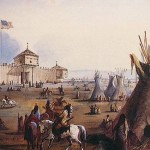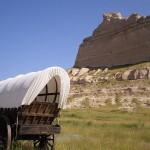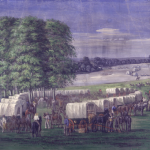Across Laramie Creek sat Fort Laramie with 12 to 15 foot walls of adobe and a large wooden gate on the south. Past the fort the mountains soared into the sky. Steuben wrote that “they are so lofty, dark, rugged, dismal and hideous that they remind me of nature in chaos.” Here the road divided. One route followed the North Platte and the other, said to be shorter, climbed into the hills. Men bound for the gold in California often opted for the shorter route and abandoned their wagons in favor of … [Read more...]
Gold Rush 49ers, massive rocks over a changing prairie
Slowly the landscape along the Platte River trail began to change. Rock outcroppings poked from the sand hills beside the valley. The plains were covered in the pale yellow blooms of prickly pear, a welcome relief from the endless miles of greenish-gray sagebrush. In the distance the shadow of the Laramie Mountains hung on the horizon, broken only by massive rocks that towered above the flat plain. The first of these, rising abruptly 400 feet above the valley, was known as Courthouse Rock … [Read more...]
Gold Rush 49ers, the Sioux after the Platte ford
At the ford the South Platte stretched three quarters of a mile across with water one to three feet deep. John C. Fremont described the river bottom as quicksand. Wagons would stick in the mire. Men unloaded supplies and ferried them across by mule back. They yoked extra mules or oxen to pull stuck wagons free. It took a team of 14 mules to get one wagon across. Powerful storms plagued the gold rush 49ers all across the plains. In 1841 Joseph Williams talked of a storm so severe that a … [Read more...]
Gold rush 49ers, the Platte River trail
Located near Grand Island on the Platte River close to where the trails from Independence and St. Joseph intersect with those from Omaha and Council Bluffs, Fort Kearney was the first place for California travelers to obtain needed provisions and make repairs on their wagons or equipment since leaving the Missouri River. There was no stockade at the fort but by the summer of 1849 several hundred wagons would be gathered close to the sod buildings built around a central parade ground. This would … [Read more...]
Gold rush 49ers, from the Missouri to the Platte
Only a day or two after crossing the Missouri from St. Joseph the first Indians galloped around the wagons and caused quite a stir among the emigrants. These were the Sac who lived on a reservation nearby with the Fox. But the first real threat would come from the Pawnee who had long been in western Kansas and were known to steal animals. If travelers lost mules or oxen they would have no choice but to return to the east. The country was mostly rolling prairie with some bottom land and … [Read more...]
Gold rush 49ers onto the Kansas prairie
”The accounts of the abundance of gold in California are of such extraordinary character as would scarcely command belief were they not corroborated by authentic reports of officers in the public service.” So said President Polk to Congress in December 1848. His words started an uproar, a fever, a fire in the hearts of so many men that it far outshone the one already blazing among those in California, the new west coast of the United States. The well-known newsmen Horace Greeley added his … [Read more...]
Steamship service to gold rush California begins
On October 6, 1848 the SS California departed New York on its maiden voyage. With the Mexican War over and California now American territory the Pacific Mail Steamship Company had acquired a contract to deliver mail from Panama to San Francisco. A United States Steamship Company ship would bring mail to the Chagres River where Pacific Mail would ferry it up river by canoe, then haul it by mule along ancient Spanish trails across the last 20 miles of the isthmus to Panama City on the Pacific … [Read more...]
Around the horn on a clipper ship, 1849
President Polk acknowledged the gold finds in California in front of congress on December 5, 1848 and men across the east coast frantically booked passage on any and every available ship. America was a sea power and for those in New York and New England a voyage was the fastest way to the gold fields. The ships were quickly loaded with both passengers and supplies of all kinds to sell at inflated prices in a burgeoning land in need of practically everything. The brig J. W. Coffin was the first … [Read more...]
Extra! Extra! Gold found in California
“The excitement and enthusiasm of gold washing still continues.” So read the headline in Sam Brannan’s San Francisco newspaper, the California Star, on June 10, 1848. The report told how every town as far south as San Diego had been stripped of citizens in a mad rush to the mines where a man could earn an average of $15- 20 per day. A total of $100,000 had been unearthed since May, huge sums then. Four days later the Star stopped publication after its workers left for the gold mines. Late … [Read more...]
Sacramento, gateway to the gold
“Canopies of oaks and cottonwoods, many festooned with grapevines, overhung both sides of the blue current. Birds chattered in the trees and big fish darted through the pellucid depths. The air was like champagne, and they drank deep of it, drank in the beauty around them. This is like the Holy Sacrament,” said a writer with the Spanish explorer Gabriel Moraga a half century before the discovery of gold. And so Moraga called the great valley and its river Sacramento after the Catholic sacrament … [Read more...]


























Follow Us!